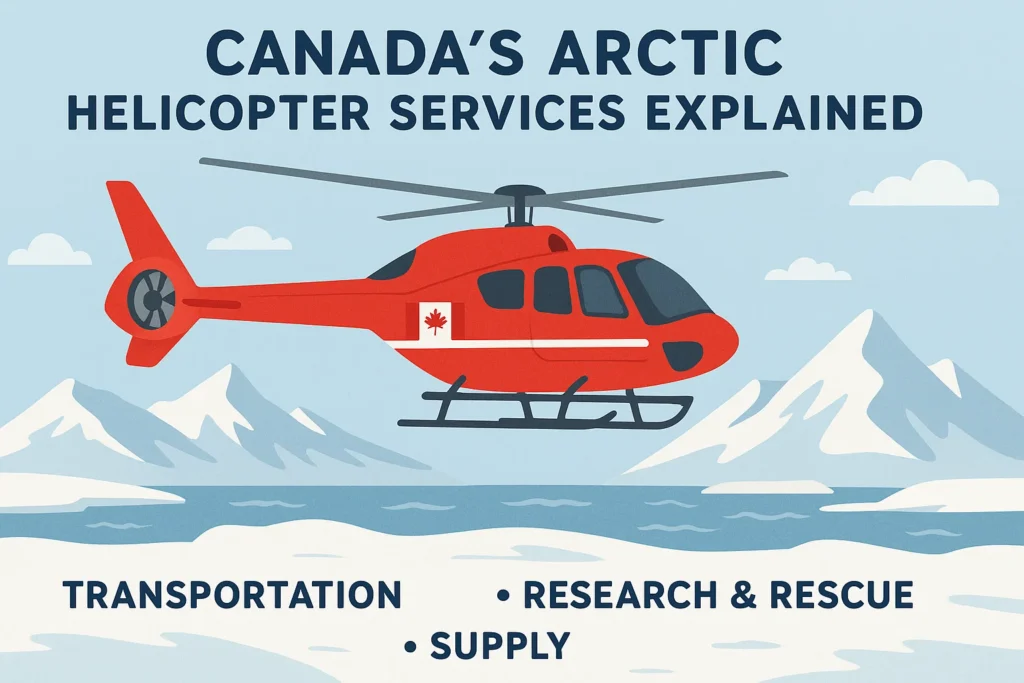🧊 Introduction: Lifting Hope in the Frozen North
Arctic Helicopter Services: Canada’s Arctic is one of the most remote and inhospitable regions on Earth — with vast icy landscapes, sub-zero temperatures, and no road connectivity for most of the year. In this unforgiving environment, helicopters are not a luxury — they are a lifeline.
At DreamSafar.in, we explore how Arctic helicopter services support transport, rescue, research, and Indigenous communities across northern Canada.
🚁 1. Remote Community Connectivity
Many Arctic towns in Nunavut, Northwest Territories, and northern Quebec are inaccessible by road. Helicopters help with:
-
Passenger transport
-
Cargo and mail delivery
-
Medical evacuations
-
School supplies and food delivery
🛩 Air Tindi and Great Slave Helicopters are key operators servicing Indigenous communities.
🆘 2. Emergency Medical Evacuations (Medevac)
Weather can delay ground-based ambulances for days. Helicopters provide:
-
Rapid ICU transfer to hospitals in Yellowknife or Edmonton
-
Winter night operations with thermal vision
-
Snow landing capabilities with special skids
⚕️ In Nunavut, air ambulance is the only emergency option for many residents.
🧭 3. Arctic Search and Rescue (SAR)
With temperatures dropping to –50°C and near-zero visibility, Arctic rescues require:
-
Specially insulated helicopters
-
Skilled SAR teams trained for snow landings
-
Real-time satellite tracking
👮 The Royal Canadian Mounted Police (RCMP) and Canadian Armed Forces operate dedicated Arctic SAR fleets.
🧪 4. Scientific & Environmental Research Support
Researchers studying glaciers, permafrost, and polar bears rely on helicopters for:
-
Access to remote observation points
-
Equipment delivery
-
Aerial surveys of ice sheets and wildlife migration
🧊 ArcticNet and Polar Knowledge Canada fund frequent helicopter-supported missions.
🏗️ 5. Resource Exploration & Industry Support
Helicopters also support mining, oil, and gas exploration by:
-
Airlifting drilling equipment
-
Transporting survey teams
-
Mapping remote geographies
📦 Operators like Canadian Helicopters Limited (CHL) and Panorama Helicopters specialize in Arctic logistics.
❄️ Key Arctic Helicopter Adaptations
| Feature | Purpose in Arctic Conditions |
|---|---|
| Heated rotor blades | Prevent ice buildup |
| Insulated cabins | Protect crew and cargo in sub-zero temps |
| Skid landing gear | Enable snow landings |
| Thermal imaging systems | Night flying and rescue |
| Emergency survival kits | Required for all Arctic flights |
📍 Major Arctic Heliports & Stations
-
Yellowknife Airport (YZF) – Main Arctic aviation hub
-
Iqaluit Airport (YFB) – Nunavut capital’s lifeline
-
Resolute Bay Heliport – Polar research gateway
-
Inuvik (Mike Zubko) Airport – Key point for oil exploration flights
🔗 Useful Links – DreamSafar.in
🌐 External Resources
❓ FAQ: Arctic Helicopter Services
❓ Are helicopters the only option in Canada’s Arctic?
For many months a year — yes. There are no roads, and fixed-wing aircraft need runways, unlike helicopters.
❓ How do helicopters operate in –40°C conditions?
They use cold-weather gear, preheated engines, and special maintenance routines.
❓ Is it safe to fly in Arctic weather?
Operators follow strict Transport Canada protocols and are trained for low-visibility and cold-weather emergencies.
❓ Can tourists use Arctic helicopter services?
Yes, especially for Northern Lights tours, glacier viewing, and Arctic Circle expeditions.
🏁 Final Thoughts
Canada’s Arctic helicopter services are a lifeline in a land of ice and isolation. Whether flying doctors, supplies, or scientists, these aircraft are the silent force keeping the North alive, connected, and researched.
Stay tuned with DreamSafar.in for more high-altitude stories from around the world.


